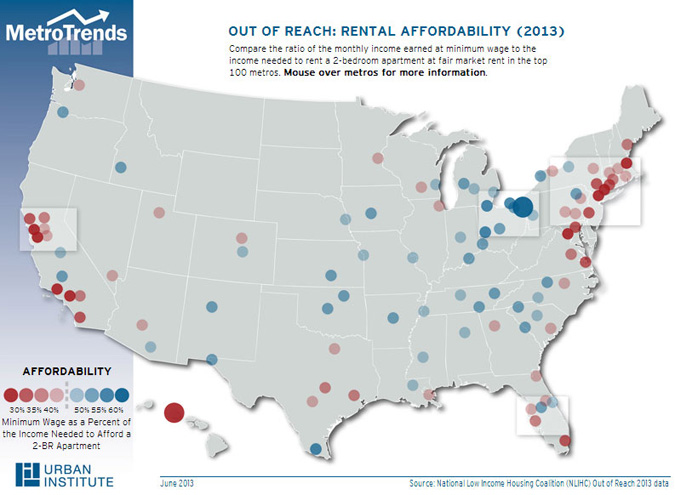
|
|
Stark Realities of Renting in America Affordable housing: For many, still out of reachMegan Bolton and Elina Bravve Topic: Housing Data Source: Out of Reach Across the country, low-income renters and their allies use the National Low Income Housing Coalition’s annual Out of Reach report to make the case for expanding and preserving our nation’s supply of affordable housing. Decent housing affordable to low-income renters is scarce. Most extremely low income renters spend over half of their tight monthly budget on housing costs alone. Others live doubled up with friends or family, squeezed into motel rooms, or subjected to substandard housing conditions. Housing subsidies are nearly impossible to obtain, with years-long waiting lists for federal rent assistance. Out of Reach helps explain these issues at the local level. The most cited statistic in Out of Reach is the Housing Wage, the hourly wage needed to afford a two-bedroom Fair Market Rent (FMR) unit while working full-time (40 hours per week, 52 weeks a year). The Housing Wage is calculated for every state, metropolitan area, combined area, and county in the country. It shows how difficult it is for low paid workers to find a decent home anywhere. The 2013 national Housing Wage is $18.79, and for the top 100 metropolitan areas, it is even higher. There are four metro areas with a Housing Wage over $30: San Francisco, CA; Stamford-Norwalk, CT; Honolulu, HI; and San Jose-Sunnyvale-Santa Clara, CA. Metro areas across the West and the Northeast continue to have higher rents and higher Housing Wages than those in the South and Midwest. Metro areas in the West and the Northeast also have the highest proportion of renters (41 percent in both regions). The two-bedroom Housing Wage is just over $23 in the metropolitan areas in these two regions. The Northeast has the highest average renter wage of the four regions at $21.75, but these earnings still fall short of the Housing Wage. There are many low-income renter households in the Northeast who make less than the average renter wage. Extremely low income renter households (those with incomes at or below 30% of the Area Median Income) in the Northeast have incomes of $21,666 a year or less. This translates into an hourly wage of roughly $10.42, far below the Housing Wage for the metropolitan areas in this region. The Buffalo, Niagara Falls, NY Metropolitan Statistical Area (MSA), and the Boise-City-Nampa, ID MSA are the most affordable metro areas in the Northeast and West, with Housing Wages of $14.15 and $13.92 respectively. But renters in these metro areas still struggle to find affordable apartments because of low wages; the average renter wage in the Buffalo MSA is $10.19 and in the Boise City MSA it is $11.48. Despite lower average rents in the metropolitan areas of the South and Midwest, the gap between housing costs and renter earnings persists. In metro areas across the South, the average two-bedroom FMR is $962 and in the Midwest, the two-bedroom FMR is $836. However, a minimum wage renter earning $7.25 an hour can only afford $377 in rent each month. An extremely low income household in the South, with income of $20,222 or less, can afford just $505 a month in rent. Even one-bedroom apartments in these areas can be out of reach for many low-wage workers. For instance, in the Charleston, SC MSA, a minimum wage worker would need to work 79 hours per week to afford the one-bedroom FMR of $740. In Minneapolis, MN, a renter household must earn $14.15 an hour to afford a one-bedroom unit. This translates into $29,440 annually, working full-time. Yet, extremely low income in Minneapolis is $24,690 a year or less. Minimum wage and extremely low income renters across the South and Midwest are still priced out of their rental housing markets. Finding a job that allows you to pay the rent and still have enough left over for other necessities is an obstacle for low-income households, but even low-income renters who have steady work often struggle to find stable housing. For low-income families, an emergency can be far more than a setback. An unexpected car repair or a sudden trip to the emergency room can lead to eviction or even homelessness. Housing instability among low income households has deep and lasting effects on families. As recent coverage of Out of Reach 2013 notes, public health research suggests ties between poor health outcomes and unstable housing among children. The United for Homes campaign aims to directly address the immediate need to increase the supply of housing affordable to extremely low income renters. The campaign proposes to fund the National Housing Trust Fund with revenue raised from modifications to the mortgage interest deduction. The modifications would convert the deduction to a 15 percent non-refundable tax credit and reduce the size of the mortgage eligible for the tax break from $1 million to $500,000. The revenue generated from this reform would go toward increasing the supply of stable, affordable housing for the lowest income Americans. Home page rental sign photo from Flickr user Patrick Gage Kelley (CC BY-NC-SA 2.0) |
Experts Feedback
Send us your comments to help further the discussion. Share
Commentaries
|




